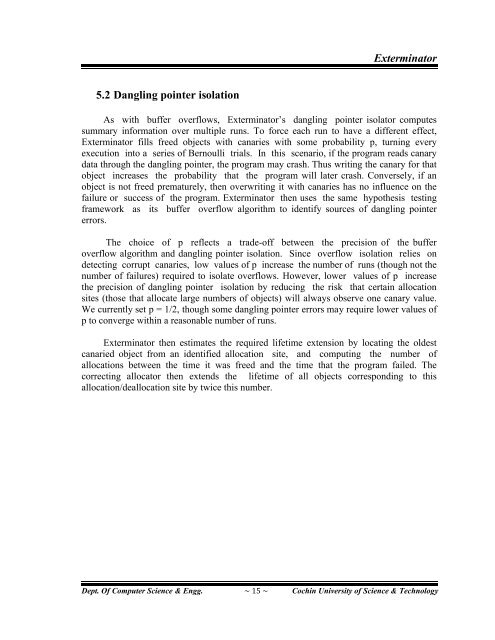Exterminator- A ... with High Probability.pdf - DSpace at CUSAT ...
Exterminator- A ... with High Probability.pdf - DSpace at CUSAT ...
Exterminator- A ... with High Probability.pdf - DSpace at CUSAT ...
Create successful ePaper yourself
Turn your PDF publications into a flip-book with our unique Google optimized e-Paper software.
5.2 Dangling pointer isol<strong>at</strong>ion<br />
<strong>Extermin<strong>at</strong>or</strong><br />
As <strong>with</strong> buffer overflows, <strong>Extermin<strong>at</strong>or</strong>’s dangling pointer isol<strong>at</strong>or computes<br />
summary inform<strong>at</strong>ion over multiple runs. To force each run to have a different effect,<br />
<strong>Extermin<strong>at</strong>or</strong> fills freed objects <strong>with</strong> canaries <strong>with</strong> some probability p, turning every<br />
execution into a series of Bernoulli trials. In this scenario, if the program reads canary<br />
d<strong>at</strong>a through the dangling pointer, the program may crash. Thus writing the canary for th<strong>at</strong><br />
object increases the probability th<strong>at</strong> the program will l<strong>at</strong>er crash. Conversely, if an<br />
object is not freed prem<strong>at</strong>urely, then overwriting it <strong>with</strong> canaries has no influence on the<br />
failure or success of the program. <strong>Extermin<strong>at</strong>or</strong> then uses the same hypothesis testing<br />
framework as its buffer overflow algorithm to identify sources of dangling pointer<br />
errors.<br />
The choice of p reflects a trade-off between the precision of the buffer<br />
overflow algorithm and dangling pointer isol<strong>at</strong>ion. Since overflow isol<strong>at</strong>ion relies on<br />
detecting corrupt canaries, low values of p increase the number of runs (though not the<br />
number of failures) required to isol<strong>at</strong>e overflows. However, lower values of p increase<br />
the precision of dangling pointer isol<strong>at</strong>ion by reducing the risk th<strong>at</strong> certain alloc<strong>at</strong>ion<br />
sites (those th<strong>at</strong> alloc<strong>at</strong>e large numbers of objects) will always observe one canary value.<br />
We currently set p = 1/2, though some dangling pointer errors may require lower values of<br />
p to converge <strong>with</strong>in a reasonable number of runs.<br />
<strong>Extermin<strong>at</strong>or</strong> then estim<strong>at</strong>es the required lifetime extension by loc<strong>at</strong>ing the oldest<br />
canaried object from an identified alloc<strong>at</strong>ion site, and computing the number of<br />
alloc<strong>at</strong>ions between the time it was freed and the time th<strong>at</strong> the program failed. The<br />
correcting alloc<strong>at</strong>or then extends the lifetime of all objects corresponding to this<br />
alloc<strong>at</strong>ion/dealloc<strong>at</strong>ion site by twice this number.<br />
Dept. Of Computer Science & Engg. ~ 15 ~ Cochin University of Science & Technology
















